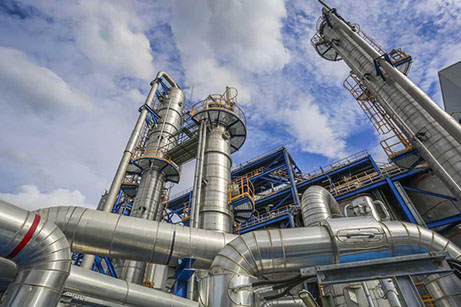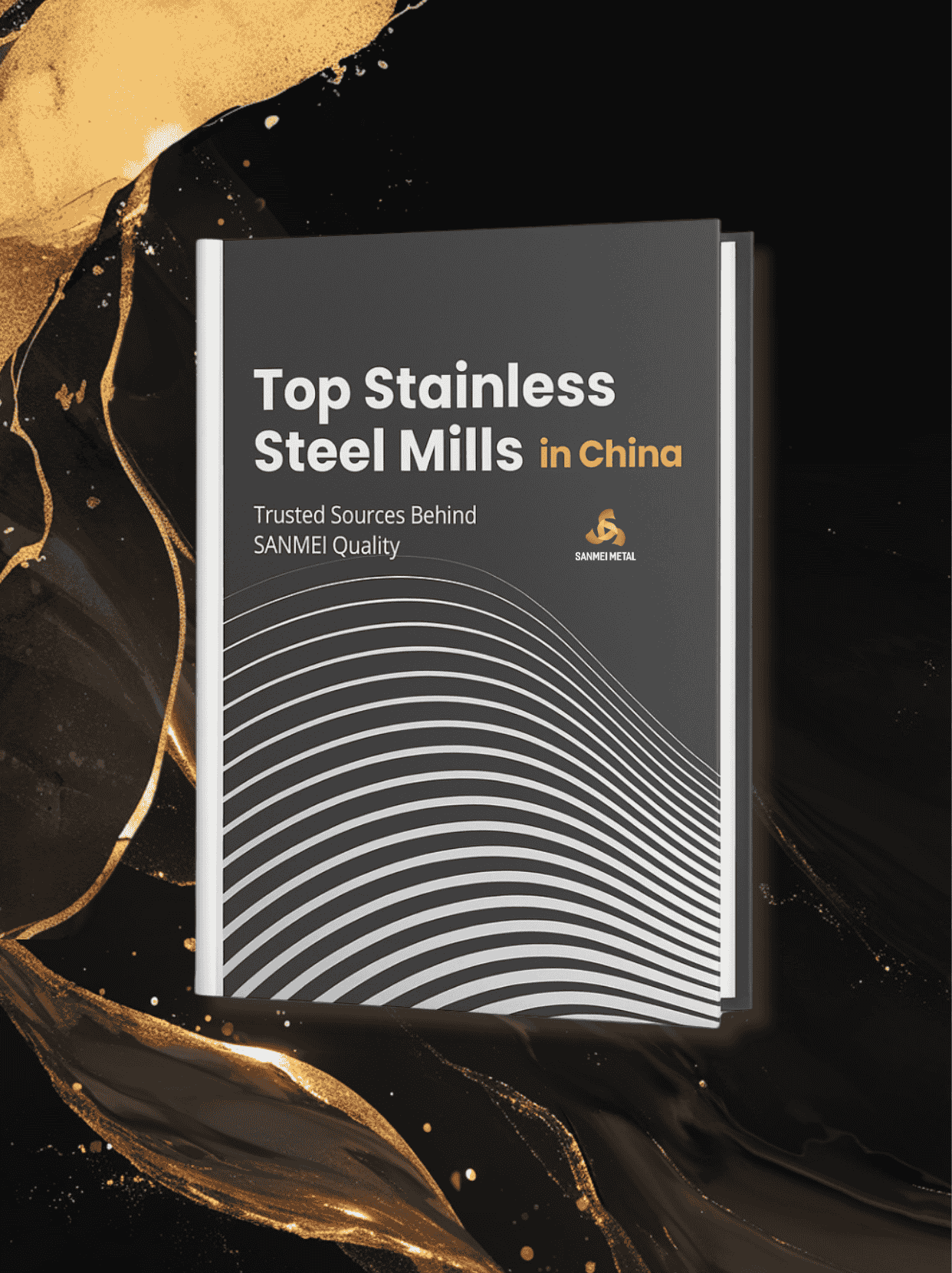309S Paslanmaz Çelik Neden Yüksek Sıcaklık Endüstrilerinde Fark Edilmeyen Bir Kahramandır?
Günlük mutfaklarımızda, mükemmel korozyon direnci ve kolay işlenebilirliği sayesinde 304 paslanmaz çelik, pişirme kapları için tercih edilen malzemedir. Ancak endüstriyel ortamlarda, özellikle aşırı yüksek sıcaklık ve aşındırıcı ortamlarda, daha güçlü bir malzeme olan 309S paslanmaz çelik, sessizce koruyucu rolünü üstlenir. Bugün, endüstriyel yüksek sıcaklık uygulamalarında bu vazgeçilmez malzemeyi ve sektörde nasıl gizli bir kahraman haline geldiğini inceleyeceğiz.

309S Paslanmaz Çelik: Yüksek Sıcaklık Endüstrilerinin Koruyucusu
Ocağa sıcak bir çorba tenceresi koyduğunuzu düşünün; tencerenin malzemesi, şeklini veya performansını kaybetmeden sürekli yüksek sıcaklıklara dayanmalıdır. Bu, 304 paslanmaz çelik için sınırdır, ancak 309S için bu yalnızca küçük bir zorluktur. 309S paslanmaz çelik, 980°C'ye kadar yüksek sıcaklıklarda stabilitesini koruyabilir ve bu da onu yüksek sıcaklık fırınları, ısı eşanjörleri, baca astarları ve otomotiv egzoz sistemleri gibi endüstriyel ortamlarda vazgeçilmez bir malzeme haline getirir.
309S Paslanmaz Çeliğin Kimyasal Bileşimi: Gücünün Kaynağı
309S paslanmaz çeliğin dayanıklılığı kimyasal bileşiminde yatar. İçeriğinde en fazla 0,08% karbon (C), en fazla 2,00% manganez (Mn), en fazla 1,00% silisyum (Si), en fazla 0,045% fosfor (P), en fazla 0,030% kükürt (S), en fazla 12,0-15,0% arasında nikel (Ni) ve 22,0-24,0% arasında krom (Cr) bulunur. Bu elementler 309S'ye mükemmel korozyon direnci sağlamakla kalmaz, aynı zamanda en az 205 MPa akma dayanımı, en az 515 MPa çekme dayanımı, en az 40% uzama ve en az 50% alan küçültme gibi olağanüstü mekanik özellikler de sağlar.
|
Tip 309'ların Kimyasal Bileşimi |
|
| Öğe | Yüzde (%) |
| Karbon (C) | ≤0,08 |
| Manganez (Mn) | ≤2.00 |
| Silisyum (Si) | ≤1.00 |
| Krom (Cr) | 22.0 - 24.0 |
| Nikel (Ni) | 12.0 - 15.0 |
| Fosfor (P) | ≤0,045 |
| Kükürt (S) | ≤0,030 |
| Azot (N) | ≤0,10 |
| Demir (Fe) | Denge |
Ancak, övünmek tek başına üstünlüğünü kanıtlamaya yetmez. 309S, diğer yüksek sıcaklık malzemeleriyle (diğer yüksek sıcaklık paslanmaz çelik sınıfları da dahil) karşılaştırıldığında bile benzersiz avantajlarını göstermektedir.
309S ve Diğer Yüksek Sıcaklık Malzemeleri
309S paslanmaz çelik, özellikle yüksek sıcaklık ortamlarında stabilite, korozyon direnci ve işlenebilirlik açısından yüksek sıcaklık malzemeleriyle karşılaştırıldığında birçok avantaja sahiptir. Diğer malzemelerle karşılaştırıldığında şu şekilde bir özetlenebilir:
Molibden (Mo)
- Avantajları: Molibdenin son derece yüksek bir erime noktası (yaklaşık 3.200°C) ve mükemmel yüksek sıcaklık oksidasyon direnci vardır, bu da onu havacılık motorları gibi aşırı yüksek sıcaklık ortamları için ideal hale getirir.
- Dezavantajları: Molibdenin yoğunluğu yüksektir (yaklaşık 10,2 g/cm³), bu da bazı uygulamalar için kullanımı zorlaştırır ve maliyeti yüksektir, bu da yaygın kullanımını sınırlar.
- 309S Karşılaştırması: 309S'in erime noktası nispeten düşük (yaklaşık 1.400°C) olmasına rağmen, yoğunluğu (yaklaşık 7,9 g/cm³) çok daha düşüktür ve daha uygun maliyetlidir. 309S, yüksek ancak aşırı olmayan sıcaklıklardaki uygulamalar için iyi bir yüksek sıcaklık performansı sunar.
Silisyum Karbür ve Silisyum Nitrür Seramikleri
- Avantajları: Silisyum karbür (SiC) ve silisyum nitrür (Si3N4) seramikler mükemmel yüksek sıcaklık (1.600°C'nin üzerine dayanabilir) ve korozyon direncine sahiptir, enerji üretimi ve havacılık alanlarında yaygın olarak kullanılır.
- Dezavantajları: Seramikler kırılgan ve çatlamaya meyilli, işlenmesi zor ve maliyetlidir.
- 309S Karşılaştırması: 309S paslanmaz çelik, mekanik yüklere kolayca kırılmadan dayanabilen, daha iyi tokluk ve işlenebilirlik sunar. Seramikle karşılaştırıldığında, 309S işleme ve kaynaklamada daha esnektir ve daha uygun maliyetlidir.
Karbon Fiber
- Avantajları: Karbon fiber hafif ve yüksek mukavemetli olup, havacılık ve roket motorlarında, özellikle nozullar gibi yapısal bileşenlerde yaygın olarak kullanılır.
- Dezavantajları: Karbon fiberin korozyon direnci düşüktür, işlenmesi karmaşıktır ve maliyeti yüksektir.
- 309S Karşılaştırması309S paslanmaz çelik, özellikle kükürt bileşikleri veya diğer aşındırıcı gazlar içeren ortamlarda üstün korozyon direncine sahiptir. 309S daha ağır olmasına rağmen, genel performansı daha dengelidir ve bu da onu daha geniş bir uygulama yelpazesi için uygun hale getirir.
309S paslanmaz çelik, kapsamlı performansıyla öne çıkar. 980°C'ye kadar yüksek sıcaklık ortamlarında uzun süreler boyunca kararlılığını koruyabilir ve molibden, silisyum karbür seramikler ve poliimid gibi birçok yüksek sıcaklık malzemesine kıyasla daha iyi mekanik mukavemet, tokluk ve işlenebilirlik sunar. Dahası, 309S'nin özellikle kükürt içeren ortamlardaki korozyon direnci, diğer birçok yüksek sıcaklık malzemesinin gerisinde kalır. Bu nedenle, 309S paslanmaz çelik, yüksek sıcaklık, korozyon direnci, mekanik mukavemet ve iyi işlenebilirlik gerektiren birçok uygulamada daha dengeli ve uygun maliyetli bir seçimdir.
309S'nin paslanmaz çelik olması göz önüne alındığında, paslanmaz çeliğin tipik "korozyon direnci" özelliklerini doğal olarak miras aldığını, sanki doğuştan başarının "altın anahtarı" varmış gibi merak ediyor olabilirsiniz. Ancak, 309S'yi diğer paslanmaz çelik kaliteleriyle karşılaştırırsanız, bakış açınız değişir mi? Şimdi, 309S'nin endüstriyel uygulamalarda paslanmaz çelikler arasında neden öne çıktığını ve neden daha iyi bir seçim olduğunu inceleyeceğiz.
309S ve 309 Paslanmaz Çelik
Hem 309S hem de 309 paslanmaz çelikler kimyasal bileşim ve fiziksel özellikler açısından benzerdir ancak belirli uygulamalardaki performanslarını etkileyen temel hususlarda farklılık gösterirler.
Kimyasal Bileşim ve Karbon İçeriği
309S Düşük karbon içeriği (maks. 0.08%) daha iyi yüksek sıcaklık kararlılığı ve azaltılmış karbür çökelmesi sağlayarak korozyon direncini artırır.
309 Daha yüksek karbon içeriği (maks. 0.20%), yüksek sıcaklıklarda karbür oluşumu nedeniyle biraz daha düşük korozyon direncine yol açar.
Yüksek Sıcaklık Performansı ve Korozyon Direnci
309S Özellikle korozif ortamlarda (örneğin sülfürler) 980°C'ye kadar olan sıcaklıklarda daha iyi korozyon direnci. Yüksek sıcaklık fırınları ve ısı eşanjörleri için idealdir.
309 980°C'ye kadar sıcaklıklarda iyi performans gösterir ancak daha yüksek karbon içeriği nedeniyle zorlu koşullarda korozyon direnci azalır.
Maliyet ve Uygulama Seçimi
309S Üretimi daha karmaşıktır, maliyeti daha yüksektir, ancak zorlu ortamlarda üstün stabilite ve oksidasyon direncine sahiptir.
309 Daha uygun maliyetlidir ve yüksek sıcaklıklara sahip ancak daha az aşındırıcı ortamlara uygundur.
Genel olarak 309S ve 309 yüksek sıcaklık ortamlarında benzer performans gösterir, ancak 309S'nin düşük karbon içeriği, özellikle sülfürler gibi aşındırıcı maddelerin bulunduğu ortamlarda daha güçlü korozyon direnci ve daha iyi yüksek sıcaklık kararlılığı sağlar. Öte yandan 309, korozyonun daha az endişe verici olduğu yüksek sıcaklık ortamları için daha uygundur ve daha uygun maliyetlidir.
| Mülk | 309S Paslanmaz Çelik | 309 Paslanmaz Çelik |
| Maksimum Karbon İçeriği | 0.08% | 0.20% |
| Yüksek Sıcaklık Korozyon Direnci | Özellikle sülfür ve diğer aşındırıcı gazların bulunduğu ortamlarda üstün | Biraz daha düşük, yüksek sıcaklıklarda karbür oluşumuna daha yatkın |
| Yüksek Sıcaklık Performansı | 980°C'ye kadar sıcaklıklarda daha iyi stabilite sağlar | 980°C'ye kadar iyi performans gösterir ancak aşırı koşullarda daha az kararlıdır |
| Uygulama Uygunluğu | Yüksek sıcaklıklı, aşındırıcı ortamlar (örneğin fırınlar, ısı eşanjörleri) için idealdir | Daha az şiddetli korozyon koşullarına sahip yüksek sıcaklık uygulamaları için uygundur |
| Maliyet | Daha düşük karbon içeriği ve daha karmaşık üretim nedeniyle daha yüksek | Daha yüksek karbon içeriği ve daha basit üretim nedeniyle daha düşük |
| Mekanik Özellikler | 309 ile benzer mukavemet, süneklik ve tokluğa sahiptir, ancak aşırı koşullar altında korozyona karşı daha dirençlidir | 309S'ye benzer ancak belirli ortamlarda korozyona karşı daha hassastır |
| Yüksek Sıcaklık Ortamlarında Korozyon Direnci | Düşük karbon içeriği nedeniyle mükemmel korozyon direnci | Uzun süreli yüksek sıcaklıklara, özellikle aşındırıcı gazlara maruz kalmaya karşı iyi ancak daha az dirençlidir |
309S Paslanmaz Çelik ve Diğer Paslanmaz Çelik Sınıfları
Diğer yüksek sıcaklık paslanmaz çelik sınıflarıyla karşılaştırıldığında, 309S benzersiz ve vazgeçilmez özellikleriyle öne çıkıyor. 309S'nin diğer birçok yüksek sıcaklık paslanmaz çelik sınıfıyla karşılaştırması şöyle:
- 309S ve 304 Paslanmaz Çelik: 309S, genellikle 500°C'yi aşmayan sıcaklıklarda kullanılan 304 paslanmaz çeliğe kıyasla üstün yüksek sıcaklık performansı sunar. Buna karşılık, 309S, 980°C'ye kadar yüksek sıcaklıklarda kullanılabilir.
- 309S ve 310S Paslanmaz Çelik: 310S paslanmaz çelik, 1375°C'ye kadar dayanabilen daha yüksek sıcaklıklar için tasarlanmıştır. 310S daha iyi yüksek sıcaklık performansı sunarken, 309S özellikle kükürt içeren ortamlarda korozyon direncinde mükemmeldir.
- 309S ve 321 Paslanmaz Çelik321 paslanmaz çelik, ostenitik yapıyı stabilize etmek ve yüksek sıcaklıklarda krom karbür oluşumunu önlemek için titanyum kullanır ve böylece korozyon direncini korur. Bununla birlikte, yüksek krom ve nikel içeriğiyle 309S, hem yüksek sıcaklık hem de korozyon direncinde üstün genel performans sunar.
- 309S ve 347 Paslanmaz Çelik347 paslanmaz çelik, ostenitik yapıyı stabilize etmek için niyobyum kullanır ve 1.093°C'ye kadar sıcaklıklara uygundur. 347 mükemmel yüksek sıcaklık oksidasyon direncine sahipken, 309S daha iyi maliyet etkinliği ve işlenebilirlik sunar.
- 309S ve 316L Paslanmaz Çelik316L, klorürlü ortamlarda korozyon direncini artıran molibden içerir ve bu da onu yüksek sıcaklık ve aşındırıcı uygulamalar için uygun hale getirir. Ancak 309S, özellikle yüksek sıcaklıklarda mekanik mukavemet açısından yüksek sıcaklık direnci ve karbürizasyon direncinde mükemmeldir.
Sonuç: 309S Paslanmaz Çelik, Sektörün Sessiz Devi
309S paslanmaz çelik, diğer paslanmaz çelik türleri kadar yaygın olarak bilinmese de, bazı endüstrilerdeki yeri doldurulamaz rolü onu endüstriyel dünyada sessiz bir kahraman yapar. Sahne arkasında çalışan o isimsiz süper kahramanlar gibi, 309S paslanmaz çelik de yüksek sıcaklıklara ve korozyona karşı mücadelede endüstrilerimizin güvenliğini ve istikrarını kararlılıkla korur. Bir dahaki sefere ısıya dayanıklı pişirme kapları elinize aldığınızda, perde arkasında ne kadar güçlü bir desteğe sahip olabileceğini düşünün: 309S paslanmaz çelik. Bu sessiz kahraman, endüstriyel güvenlik için hayati bir güvencedir.
SS309S korumasına mı ihtiyacınız var? Bize Ulaşın Bugün!








